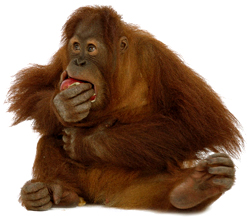DK Science: Biochemistry
The study of the chemical processes of all living things is called biochemistry. These processes include respiration (breathing) and the digestion of food. Carbon atoms can combine in so many ways that living things are mainly made up of molecules containing carbon. The molecule DNA carries the chemical instructions that allow living things to create and make copies of their molecules and reproduce.
All living things need food for the energy to make all the other body processes happen, such as growth, movement, and repair. These complicated chemical reactions are called metabolism in animals. Plants make their food, through a process called photosynthesis.
Many foods, including apples, contain molecules called carbohydrates. When broken down through the process of digestion, carbohydrates release a lot of energy. Food contains two other kinds of molecule: fats and proteins. Fats are another good source of energy, and proteins are important for growth.
The carbohydrate sugar contains 12 carbon atoms, 22 hydrogen atoms, and 11 oxygen atoms. Once eaten, the molecules are broken down to form simpler glucose molecules through the chemical process of digestion. Digestive enzymes, such as amylase, speed up this process.
Glucose molecules pass into the bloodstream and are carried to cells around the body. Every cell uses glucose molecules in a chemical process called respiration. In respiration, the bonds within the glucose molecule break, releasing the energy in the molecule in a form our bodies can use.
Glucose molecules react with oxygen in the air we breathe to release energy and create carbon dioxide (CO2) and water (H2O) molecules. Processes that release energy, such as respiration, are called catabolic reactions. Other processes that take in energy, such as building proteins, are called anabolic reactions.
Living things do not only break down molecules, but they also build up complex molecules, such as muscle proteins. Protein molecules are needed for growth. They are made from amino acids, which come from protein-rich food, such as beans, pulses, and meat.
Amino acid molecules are made of carbon, hydrogen, oxygen, and nitrogen atoms. They join up to form protein molecules, the building blocks of our bodies. Our 20 different amino acids make thousands of proteins.
The cells of our skin, blood, hair, and muscles are all made up of proteins. There are thousands of different proteins in our bodies, including the enzymes that drive every reaction and the antibodies that fight disease.
Probably the most amazing molecule in our bodies is one called deoxyribonucleic acid, or DNA for short. This molecule contains the genes (instructions) for making every different type of protein in our bodies. Almost every cell in our bodies contains DNA, divided up into 46 parts called chromosomes. Each cell uses just the part of the instructions it needs. For example, only a muscle cell makes muscle proteins.
Almost anything we do, such as gymnastics, talking, or reading, relies on our protein-built muscles. Inside every muscle cell, a chemical reaction converts the energy contained within the chemical bonds of ATP (adenosine triphosphate) molecules into movement. This reaction also creates heat, which is why you get hot when you exercise. When ATP molecules are made to store energy, anabolic reactions occur. When energy is released, catabolic reactions occur.

